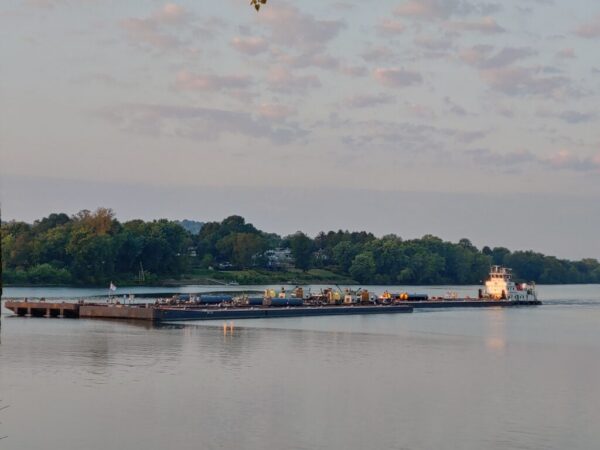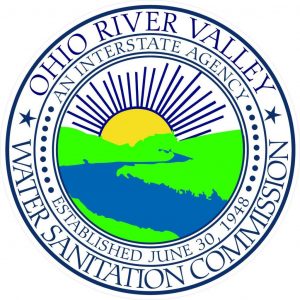- Like
- Digg
- Del
- Tumblr
- VKontakte
- Buffer
- Love This
- Odnoklassniki
- Meneame
- Blogger
- Amazon
- Yahoo Mail
- Gmail
- AOL
- Newsvine
- HackerNews
- Evernote
- MySpace
- Mail.ru
- Viadeo
- Line
- Comments
- Yummly
- SMS
- Viber
- Telegram
- Subscribe
- Skype
- Facebook Messenger
- Kakao
- LiveJournal
- Yammer
- Edgar
- Fintel
- Mix
- Instapaper
- Copy Link

A barge on the Ohio River. Photo by Robin Blakeman
Many of our allies and volunteers attended the June virtual Ohio River Valley Sanitation Commission (ORSANCO) meetings on June 10 and 11. The all-virtual technical and commission meetings were a historic first for ORSANCO. The online format allowed for all participants to post questions in a chat window, and these were answered in a timely way.
Overall, this format seemed to allow for more interaction between a broader range of participants and the commission and technical committee representatives. We were well represented by the leaders of the ORSANCO Watershed Organizations Advisory Committee (WOAC). Congratulations to our West Virginia ally, Angie Rosser, who is now the chair of that committee. Staff member Robin Blakeman and volunteer Randi Pokladnik are OVEC’s representatives on WOAC.
Here is a run-down of major topics discussed during the June virtual meetings:
- The challenges of working from home and/or continuing water monitoring processes in the midst of the COVID-19 pandemic: ORSANCO has encouraged their employees to work from home whenever possible and are limiting water monitoring to places where day-trips are possible for their employees, and requiring employees to travel separately, or with physical distance and masks if/when they need to work and travel in pairs. Almost every state that borders/regulates the river has incurred some limitations to their monitoring program during the pandemic.
- ORSANCO officials postponed the Ohio River Sweep event in the Cincinnati area until August, and are encouraging the managers of other locations for this event to choose a date and a format for the event that follows each state’s gubernatorial guidance on physical distancing, mask wearing, and other sanitation/safety procedures.
- Some of ORSANCO’s monitoring processes—such as fish tissue sampling need to be resumed by early August—or there will be gaps in the 305B report; ORSANCO is working closely with Region 5 EPA officials to figure out how to handle this.
- There are limitations to what ORSANCO can do to sample for some critical contaminants, such as bacteria, and organic chemicals; the start of the proposed PFAS sampling program this year is also questionable due to COVID-19.
- Emergency response is the least affected function of ORSANCO at this time; ORSANCO officials are working to ensure that emergency/spill response is still possible.
- A new impairment from the 2020 Biennial 305b report: two/thirds of the River (641.5 miles) is now impaired for contact/recreational uses.
The WOAC report to the commission included a fact sheet that had been developed by OVEC, Concerned Ohio River Residents and WV Rivers Coalition. We used the fact sheet to inform the commission about the three oil and gas barge facilities proposed for the Ohio River. Among the concerns we highlighted:
Pollution/Spill response concerns:
- It is unclear who would have jurisdiction/responsibility for records keeping and spill response planning, and whether those entities have clear channels of communication about the contents of these barges.
- There is a lack of appropriate testing methods for radionuclides; some of this waste could be radioactive (especially if from the Marcellus and Utica shale fields).
- The Martins Ferry barge dock would be close to the Wheeling, WV water intake on the Ohio River and many communities up and down the river (such as Bridgeport ) have shallow aquifers, susceptible to contamination from the river because they don’t have a solid barrier protecting them from the river.
- USCG does not provide for any public notification, public comment period, or public records access on horizontal fracking related waste barges; they approve applications for this type of oil and gas waste on a “case by case” basis.
- Toxic contents of unconventional oil and gas drilling waste are not among the chemicals tested for at source water intakes, nor at ORSANCO testing stations. Common contaminants in fracking waste include chemical additives, such as ethylene glycol, naphthalene, and sulfuric acid —all toxic to human health; metals and organic compounds, for example, barium is linked to gastrointestinal disturbances, muscle weakness, and paralysis; BTEX (benzene, toluene, ethylbenzene, xylene), for example, benzene is a carcinogen, and linked to blood disorders such as anemia, and toluene is linked to nervous system, kidney, and liver problems; salts or total dissolved solids, which corrode infrastructure, and harm aquatic life and vegetation; NORM (naturally occurring radioactive materials) such as radium-226 and radium-228, both of which are- carcinogenic, linked to blood disorders. (These isotopes are found in brine associated with the salt deposits in the Marcellus Shale and are brought to the surface along with produced water during fracking).
- Current drinking water treatment would probably be unable to filter out these contaminants if a spill occurred.
- Current standards for chemicals in fracking fluids, such as toluene, benzene and xylenes—established over 30 years ago—are NOT adequate to protect human health.
- Fracking waste contains TENORM (technically enhanced radioactive materials) that can contain water soluble radium 226 and 228, according to a March 20, 2020 EPA report, at 120 pCi/gram. These radionuclides can only be removed by osmosis and ion exchange methods; neither technique is used by most public drinking water facilities in our region. (The EPA has set a legal limit for Radium 226 and 228 combined at 5 picocuries per liter.)
- Levels of radium could be much higher because of inadequate testing methods. https://www.sciencemag.org/news/2015/04/study-raises-questions-about-measuring-radioactivity-fracking-wastewater
Several of our allies and network members spoke during public comment periods. Following are some quotes from their comments:
Bev Reed:
I am a near life-long resident of Bridgeport, OH – a small town about 2 hours directly West of Columbus, along the Ohio River. I am also a community organizer and liaison with a citizens’ advocacy organization, Concerned Ohio River Residents. We have been spreading the truth behind the downsides to the proposed PTT Global ethane cracker plant in Belmont County, OH for about a year a half. As if the cracker plant wasn’t a big enough threat for quaint little Belmont County, we learned of the proposal of this barge docking facility that could be located in Martins Ferry…
…This facility, if built, would be about 1 ½ miles from my home and about a mile from my town of Bridgeport’s drinking water wells. This past April, we learned of the company named 4K Industrial. We learned that they would barge in waste from the oil and gas fields to be treated at the facility that already exists at the same location.
Kelsey McNaul:
My name is Kelsey McNaul, and I am a regional organizer for the Climate Reality project. I co-lead work on our petrochemical opposition campaign in the Ohio River Valley, including the states of PA, WV, OH, and KY. The regional basis of my work particularly piques my interest in this meeting because, aside from national legislation, ORSANCO is one of the only multi-state bodies I can address in my work around the Ohio River. I worry for the commission’s position as a friend to the petrochemical industry, rather than a champion for Ohio Valley communities. The economic writing on the wall indicates a decline in the oil/gas/petrochemical industry, meanwhile, grassroots resistance to this industry is strong. Supporting the petrochemical industry, and dangerous activities associated with it such as the barging of toxic and radioactive oil and gas waste on the Ohio River will put ORSANCO on the wrong side of history for this region. For the Ohio Valley to prosper, we must protect the Ohio River from the dangerous impacts of oil, gas, petrochemicals, and plastics.
Alice Melendez:
Across the United States, according to the US Geologic Survey, about 2.5 billion gallons of brine is produced a day. [This] brine contains heavy metals, toxic levels of salt, and radium. Radium flows with water, can travel with dust, and can be breathed or ingested into the human body. Because radium has a chemical make-up similar to calcium, once inside the body it accumulates in bones. EPA regards radium as so toxic that the agency’s safe drinking water limit for the two most-prevalent radium isotopes combined is 5 picocuries per liter. Liquid waste containing above 60 picocuries per liter ‘is defined as radioactive…’ Radium in brine from the Marcellus in Pennsylvania has been recorded as high as 28,500” Justin Nobel author of America’s Radioactive Secret in Rolling Stone 21 Jan 2020.
I would like to encourage ORSANCO to fill a gap in monitoring and advocacy for clean safe source water, in the area of radioactivity.
All of these concerned citizen comments plus the fact sheet developed by OVEC and our allies seemed to raise some eyebrows among the commissioners. Some called for examination of these issues in the near future.
Once again, vocal citizens have influenced this regional commission towards taking up emerging issues that we know are going to be important as the industry and politicians push for a build-out of oil, gas and petrochemical infrastructure gets built in the Ohio River Valley.
Get involved! Contact robin@ohvec.org to join in our ORSANCo work, and take part in the Army Corps of Engineers’ August 7 virtual public meeting re theDeep Rock barge facility, near Marietta, Oh. nformation on the meeting, and how to register to attend via email is included here.











